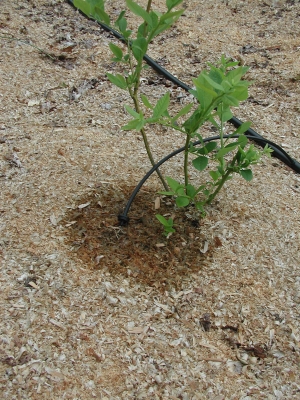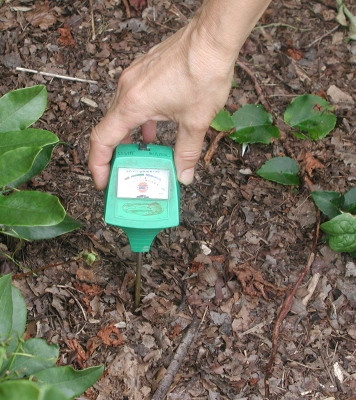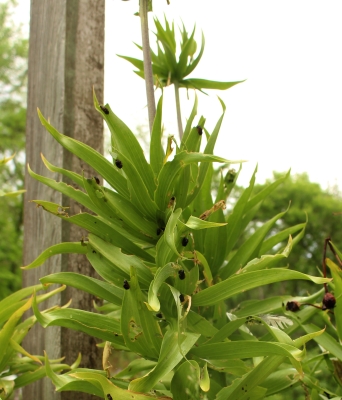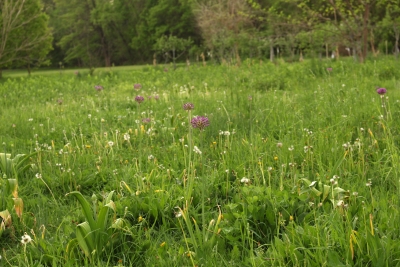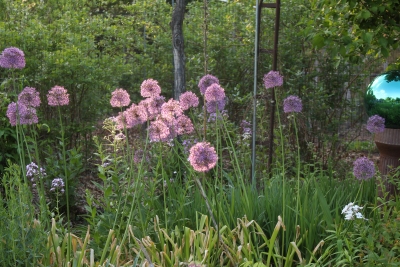DRIP, DRIP, DRIP, WHERE’S THE AGUA?
/8 Comments/in Flowers, Fruit, Gardening, Houseplants, Soil, Vegetables/by Lee ReichI’m Dripping, So Why Am I Watering?
Up to a couple of weeks ago, little water had dropped from the sky this spring here in the Hudson Valley. But a drip irrigation system automatically waters many of my plants. So why have I been spending so much time with hose in hand?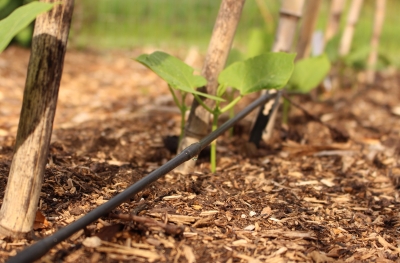
Not all my plants drink in the drips. Trees and shrubs are on their own except their first year in the ground when I religiously hand water them every few days initially, and then once a week throughout the season. These plants get 3/4 gallon per week for every square foot spread (estimated) of their root systems. That’s equivalent to an inch of rainfall which, if it does fall, exempts me from a few days of watering.
A couple of inches depth of hay, leaf, or wood chip mulch around the trees and shrubs seals in moisture to make best use of my efforts. Also, I start with smaller plants — less than 4 feet tall — which become independent of my watering sooner because a larger proportion of their roots are soon foraging around in surrounding soil that those of larger plants.
My flower beds also don’t get dripped. Although the soil surface is dry, moisture carried over from winter still sits in lower depths, into which established perennial flowers’ roots can tap. Annuals and newly planted perennials need to be watered on the same schedule as young trees until their roots reach that moisture.
It is my garden vegetables that drink in the benefits of my drip system. But even here some hand watering is needed these days. Down each bed runs 1 or 2 drip lines, with emitters along the lines spaced 6 inches apart. As water enters the soil, capillary pull from small spaces between the soil particles draws water sideways and, along with gravity, downward. The resulting wetting fronts have the shape, if you could look at a cross-section of the soil, of an ice cream cone. In clay soils, with small particles and, hence, a lot of capillary draw, that ice cream cone is very fat; in sandy soils, it’s narrow, a couple of feet wide at its broadest as compared with the 6 foot spread in a clay soil.
The wetting fronts start their sideways spread below the soil surface, deeper in sandy soils, more shallow in clay soils. In either case, the soil surface remains dry except right at the point of drip. So any vegetable transplants or seeds I set in the ground need to be hand watered until their roots reach the wetting front — except for seeds or transplants set right under or along the drip line.
Drip Irrigation Workshop June 20th; see “Workshops“, at this site, for more information.
A Statue of David
My friend David was wondering why the leaves of his Romaine lettuce plants flopped down. I gave my usual response to most gardening questions: “Too little water.” (My other usual response is “Too much water,” often following my first response if the questioner tells of watering all the time.)
So I asked David how much he watered, and he said he thoroughly soaked the ground by spraying it with water. Busted! It really was a water problem, too little in this case.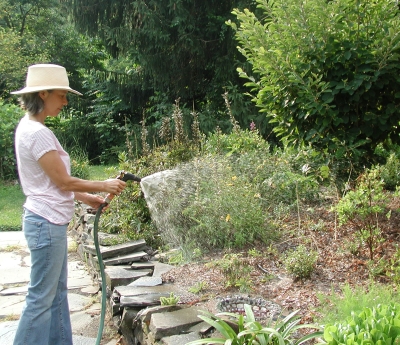
In fact, thoroughly wetting the soil with the usual 4-foot-diameter, hand held spray is almost impossible. “Thoroughly wet” means soaking the ground to at least a 6-inch depth. For his hand held sprayer to do that, David would have to stand in place like a statue, sprayer in hand, unmoving, for about an hour to wet one 4-foot-diameter part of the garden before moving on to the next 4-foot-diameter area.
When I’m watering plants in the ground by hand, I’m wetting only the small area beneath an individual plant, just enough to soak its roots as they establish themselves in the surrounding soil.
Probe the Soil
People find it hard to believe that that statuesque watering posture is really necessary. All you have to do is scratch the soil surface after a David-esque spraying of plants to see how deeply the water percolated, and you’d find only a thin layer of wet soil, at the surface.
Digging a hole in the ground is a good way to tell if watering was sufficient. But it’s also inconvenient.
For just a few dollars, I invested, years ago, in an electronic gizmo that bypasses all that hole digging. This soil moisture sensor has a metal probe that you plunge into the soil. Atop the probe is a dial or digital readout that tells whether the soil is “DRY,” “WET,” or something in between. More accurate sensors cost over a hundred dollars, but the cheap ones are fairly accurate and work well if coupled with observation.
Good for Pot(s) Also
The soil moisture meter is especially useful with potted plants, which might need watering every day when the weather is warm, sunny, and breezy. (With experience, lifting a pot to feel its weight is also a good measure of moisture level, as is just getting to know your plants better.)
I’m still hand watering the pots because I haven’t yet connected the drip tubes that will direct water to each of the pots.
MONOCOT THREATENED, MONOCOT SUCCESS
/8 Comments/in Flowers, Gardening, Pests/by Lee ReichDRIP, DRIP . . . A WORKSHOP
Drip irrigation has many benefits: saves water, healthier plants, easily automated, less weeds. I’ll be holding a DRIP IRRIGATION WORKSHOP on June 20, 2015 in Bloomington, NY. Learn why drip is the better way to water and the components and designing of a drip system. And then, hands-on, we’ll design an install a system in an existing vegetable and flower garden. For registration and information, go to www.leereich.com/workshops.
Lily Turds
The turds on my crown imperial plants were unwelcome, but no surprise. I’d been forewarned that the red lily beetle (Lilioceris lilii) was in the area. Finally, it found my garden and my crown imperials.
For a relatively mobile insect, the beetle was surprisingly slow in its arrival. This native of Europe made its North American debut in Montreal in 1945 and its entrance stateside, in 1992, in Massachusetts. Since then, it has spread. Gardeners are on alert for the beetle as far away as the Pacific northwest since its sighting near Seattle in 2012.
Those turds I saw actually are turds, the beetle larvae’s excrement, piled on their backs as they feed. Perhaps the greenish brown slime that hides the red larvae will not make the larvae unappetizing to my ducks or chicken. Those larvae are hatchlings from eggs adult beetles laid a few weeks ago. After a few weeks of feeding, the larvae will pupate. New emerging adults will feed until making their way to their winter homes in fall. The worst culprits, in terms of plant damage, are the larvae.
There are many ways to skin a cat, and many ways to deal with red lily beetles, none of which need involve highly toxic pesticides. Easiest, of course, would be to avoid growing susceptible plants. Mostly, the beetles fare are lilies (Lilium spp., which does not include daylilies) and Fritillaria species, which includes crown imperials. Susceptibility varies among lily species, with Asiatic hybrids the most vulnerable and some Oriental hybrids more resistant. Lilium henryi ‘Madame Butterfly’, Lilium speciosum ‘Uchida’, and Lilium ‘Black Beauty’ are among the most resistant.
Because I’m already growing lilies and fritillarias, I might opt for the wait and see approach, hoping for the chickens or ducks to take care of the problem. Or take the mano a mano approach, regularly inspecting plants to pick off eggs, larvae (yuck), or adults by mano. A container of soapy water held under a leaf is useful for handpicking adults because they drop soil-ward when disturbed — also emitting a defensive chirp or squeal.
Neem is a relatively nontoxic (to humans) pesticide and deterrent extracted from, you guessed it, the neem tree, in India. It’s effective if sprayed on very young larvae. I have too many crown imperial plants scatted about to easily spray.
Best of all would be to find some natural controls, and they have been found. Three species of parasitoid wasps (Lemophagus errabundus, Diaparsis jucunda, and, especially, Tetrastichus setifer) have proven effective. Releases have been made in New Hampshire, Rhode Island, Maine, and Connecticut. Come on, New York, let’s get some parasitoids.
What Beautiful Onions, Thank You
Moving on to another monocotyledenous plant, this one with no pest to speak of: ornamental onions, which also go by their botanical name, alliums.
(“Monocotyledonous,” what a mouthful! This refers to the plants leaves, or cotyledons, which function either as seed leaves or as storage structures. Monocots are one broad group of flowering plants; dicots, with two seed leaves, are the other broad group).
Last fall I reported on my planting of Allium giganteum ‘Ambassador’, which makes volleyball-sized heads of purplish blue flowers, and A. hollandicum (or A. aflatuensis) ‘Purple Sensation’, bearing similar flowers in tennis ball- sized heads. Both are nice plants for flower beds, but, as I reported, I wanted to see if they would naturalize in my south meadow.
Early on, this spring, the experiment seemed a success. The broad, green, strappy onion leaves unfolded, drinking in sunlight, before the surrounding grasses and other meadow plants had hardly budged. As warmer weather moved in, surrounding vegetation grew more boldly, soon beginning to get the upper hand on the onions.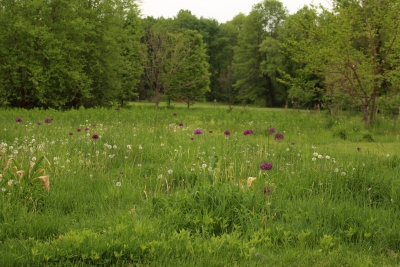
Then the onions, the smaller ‘Purple Sensations’ onions, began to bloom. The blue heads were lost, at first, in the sea of dandelions, orchard grass, goldenrod, and other plants coming on strongly. But ‘Purple Sensation’ heads evidently weren’t yet at their peak. They came increasingly into focus as the heads continued spreading their starbursts of blue blossoms. ‘Ambassador’, as I write, has still to show its heads.
Flowers are pre-packaged within fall-planted bulbs. The true test will be whether or not the alliums bloom as strongly, or at all, next spring. Perhaps the ‘Ambassador’ bulbs will even multiply, as they have in the less competitive terrain of the flower garden.
MORE PRUNING, AN INVASIVE?
/8 Comments/in Fruit, Pruning/by Lee ReichTraining Sessions
Anyone appalled at the apparent brutality with which I approached my grape and kiwi vines a few weeks ago, pruning shears, saw, and lopper in hand, would have been further shocked today. But no harm done. (The kiwis are “hardy kiwis,” that is, Actinidia arguta and A. kolomikta; fuzzy kiwis are not cold-hardy here.)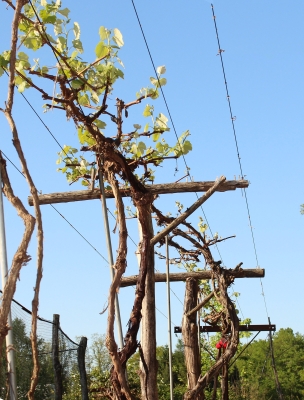
Left to their own devices, grape or kiwi vines would, every year, grow larger and larger, eventually, if once coming upon something to climb, sending their fruits further and further out of reach. Or, if not out of reach, then increasingly tangled in a mass of stems. In the dank interior of that mass of stems, many a grape would have rotted rather than ripened.
Most importantly, though, grape or kiwi berries on untended vines don’t taste that good. Self-shading cuts down flavor-producing photosynthesis. And the plants’ energies must be spread among too many fruits; pruning limits yield but lets the plants pack more flavor into what fruit remains.
The first thing I did, when I began pruning a few weeks ago, was re-organize the vines. Both bear fruits on new shoots growing off one-year-old canes. I train these plants on T-shaped trellises, with 5 wires stretched from T to T. A trunk rises to the height of the wires, at which point it bifurcates into cordons — permanent arms — each traveling in opposite directed up and down the middle wire. The one-year-old fruiting canes are splayed out perpendicularly to the cordons.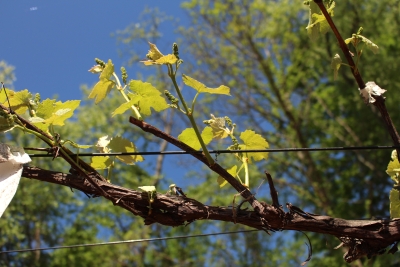 Both vines grow prodigiously every year, the fruiting canes too long and too abundant. So I shortened all the canes to 3 to 4 feet long, which was just beyond the outer wires, and cut off those super-vigorous ones having stratospheric aspirations.
Both vines grow prodigiously every year, the fruiting canes too long and too abundant. So I shortened all the canes to 3 to 4 feet long, which was just beyond the outer wires, and cut off those super-vigorous ones having stratospheric aspirations.
Still too many canes: So I reduced their numbers. A couple of weeks ago, I went over the vines again, aiming (ideally) for one cane on either side of the cordon every 6 inches or so.
Round Three, of Pruning Grape & Kiwi
The average date for the last killing frost here is around the third week in May. Evidently not so, this year, but I wanted to wait to do the final grape and kiwi pruning until after that date. The tips of the canes would be the first to grow and, hence, frosted, which is not a problem if the canes would anyway be shortened again.
Now that frost is probably just a memory, I thinned out the canes one last time — to almost a foot apart — and further shortened those that remained. The grape canes got shortened to two buds each and the kiwi canes to about 18 inches long.
Grapes, In the Bags
The next order of business, for just the grapes, will be bagging the bunches. I’ll wait until the berries have begun to swell and then partially slit the folds of delicatessen bags so that they can be slid over a bunch with the stem holding the bunch sliding into the slits. Each bunch has a leaf or a tendril opposite the bunch which needs to be clipped off so the top of the bag can be tightly folded over the stem, then stapled shut on either side, just below the slit.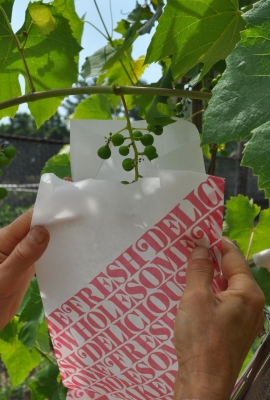
To see rather than, or in addition to, read about bagging grapes, see my video.
Why the bags? To keep diseases, birds, bees, and other insects at bay. With this protection, ripe bunches can be left hanging longer than usual to develop very rich, sweet flavor. Worst case scenario is that a bag is opened and there’s nothing inside. This sometimes happens. Best case scenario is peeling open a bag to reveal a perfect bunch of grapes with perfectly ambrosial flavor.
Hardy Kiwi, J’Accuse!
I’m glad I planted the hardy kiwi vines many years ago because it may be illegal to do so in the future. Yes, illegal! No, not because you can smoke the plant, but because has raised eyebrows in certain invasive plant circles. Nonetheless, it’s a very attractive vine with very tasty fruits. And mine have remained well-behaved in the quarter of a century that they’ve been in the ground.
In case fellow New Yorkers were not aware of this, as of March 10, 2015 it will no longer be legal to buy, sell or transport 126 species identified by the New York State Department of Environmental Conservation as invasive. Sixty-nine of these species are plants; hardy kiwi vines are not one of them — yet.
I don’t doubt that there are plants that threaten to take over the world. Well, not the world, but certain ecosystems. Which is why garlic mustard, Japanese knotweed, and autumn olive are on that most unwanted list, despite their qualities. Autumn olive, for example, enriches the soil with nitrogen garnered from the air by symbiotic microorganism at its roots. Its flowers sweetly perfume the air in spring. And the small berries that ripen in early fall, if harvested as soon as they have lost their astringency, are rich in flavor and super-rich in healthful phytochemicals known as lycopenes.
Hardy kiwifruit has not been banned anywhere, but in 2012 Massachusetts Audubon Society published an Invasive Plant Pest Alert strongly urging people not to grow or propagate this plant. Their statement was based on apparently rampant growth that was documented at two sites in Massachusetts and one in New York.
The findings don’t jive with the good behavior of numerous vines that have graced gardens, as ornamentals, in Eastern U.S. since the late 1800s. Perhaps most of those planting included only female or only male plants, in which case no viable seeds would be produced, although the vines could also have spread by climbing trees or rooting where they touch ground under the right conditions.
Male and female kiwi vines do socialize when grown for fruit in commercial and research plantings. But again, plants hardly, if ever, have multiplied on their own at these locations, which concurs with my observations here on the farmden.
As a general rule, only 10 percent of any introduced species are likely to become established on foreign ground, and only 10 percent of those plants are likely to become invasive. Let’s be very careful in our condemnations and not blow the threat of invasive species out of proportion.
Plant Sale Saturday
This Saturday, May 30, 2015, Permaculturesque Plant Sale at my New Paltz, NY farmden, from 10 am until 2 pm. Ornamental plants, edible plants, and ornamental AND edible plants such as 2 crop figs, hardy oranges (Poncirus), rosemary, dessert gooseberries, delicious and nutritious black currants, and much more.

